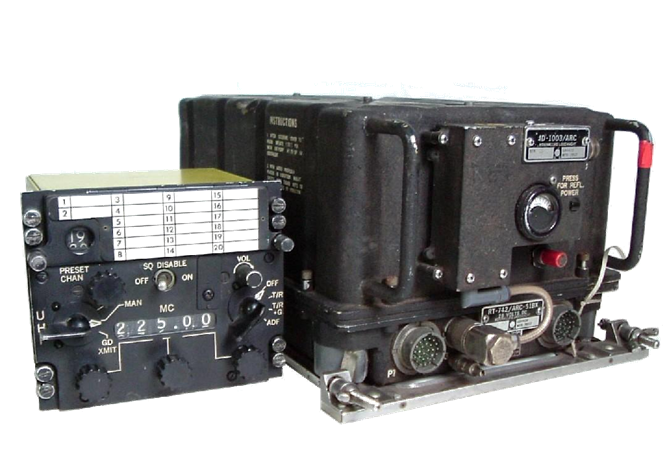


|
Last update 7 August 2010 |
|
Communication |

|
1962 |




|
VINTAGE AVIONICS |
|
AN/ARC-51BX |
|
C-6287 / ARC control panel RT 742/ ARC51 transceiver (click to open the units)
This UHF transceiver was widely used in military aircraft and on the ground throughout the seventies. This remote controlled, very compact set, operates with AM in the 225-400 MHz military communications band., and was made by Rockwell-Collins. The unit is powered by 28Vdc, and with 20W RF output, the dc input current is 10A. A control panel is needed to set the frequency, and stores 20 preset frequencies. The modular unit contains 11 (planar) tubes of 6 different types and 71 transistors.
TypesThe original ARC-51X had 1750 channels with 100kHz spacing, soon followed by the ARC-51A, B, AX or BX , all with 3500 channels at 50kHz spacing. The A stands for a telephone impedance of 150 ohm, B is 600 ohm. There is one fan inside ( sounds like a jet engine), and another outside the pressurized unit. The "X" indicates that both fans are powered from the internal dc/ac/dc inverter. Without the “X”, an external 400Hz source is required only for the fans. Inside the unit are straps to select : carbon or dynamic microphone, 150 or 600 ohm telephone, silence or tone during channel changing, and 4 or 6 kHz audio bandwidth.
Removable parts fixed to outside of case: ID-1003/ARC Standing wave ratio indicator ( mounted on front, see above) HD-615/ARC-51 Air cooler and filter, mounted on rear of RT742(*) The PRC-41 is a portable version of the ARC51 with 1750 channels, and 3W output.
Frequency control Three rotary knobs on the radio control select the tens of MHz (18 positions), units MHz (10 positions) and kHz (20 positions, in 50kHz steps). Each rotary switch position is transferred by 5 or 6 contacts to the ARC51-BX. The receiver is a triple superhet, the first knob controls the first local oscillator (LO) , etc. There are 18 + 10 + 20 = 48 Xtals, selecting 18 x 10 x 20 = 3600 channels. The first 100 are below 225MHz and may not function well. During transmit (key down), the oscillator frequencies are added backward from third to first LO using the same IF filters as in the receive mode. This requires a lot of relays. The intermediate frequencies are 20-30 MHz ( tuned), 2.9-3.9 MHz (tuned) and 500kHz (fixed). More details here The first local oscillator ( 200-370 MHz in 10MHz steps) has 18 crystals. Its predecessor, the ARC27 had only one crystal (10MHz) , followed by a harmonics spectrum generator. Still, the first Local Oscillator in the ARC51 is called “the spectrum generator” as well. The radio control C-6287/ ARC-51 allows either manual frequency selection , or one of 20 preset channels. Presets are programmed by shifting 8 pegs over 19 positions on a rotating drum. For details and circuit diagram look here
Guard receiver A separate 243MHz guard receiver is inside the ARC51, operating in the T/R+G position of the mode switch. When the frequency mode switch is in “GD XMIT“, the unit not only receives on this guard frequency, but transmits there as well.
Automatic Direction Finder The ARC51 can be connected to an automatic UHF Direction Finding Antenna. This is the AN/ARA-25 with tubes, or the solid state version AN/ARA-50. An external coax relay switches the ARC51BX antenna cable from the normal communications ( blade) antenna to the directional antenna when “ADF” is selected on the radio control, except during transmit. More on its function here.
AN/ARC51BX Circuit diagrams External wiring to control, headset and power External wiring by Collins
Special versions The AN/ASQ-19 and AN/ASQ-88 nav/comm bundles had a modified ARC51BX as the comm part . This was the RT-793/ ASQ ( 1964) This version accepts frequency control in BCD format thanks to a built-in BCD into 2-out-of-5 code translator. Further, the power supply has no inverter transistors , instead the transformer is fed directly with 400Hz, like the fans. The external fan is not placed on the rear, but on the side of the unit. You can find pictures and more about the ASQ-19 here.
The PRC-41 is a portable version of the ARC51 with 1750 channels, and 3W output. |
UHF Transceiver |